Business Law Assignment: Analysis of Contract and Company Law Issues
VerifiedAdded on 2021/06/17
|5
|931
|21
Homework Assignment
AI Summary
This Business Law assignment analyzes two key legal issues. The first issue concerns the liability of a school for damages and the validity of an exclusion clause, referencing cases like L'Estrange v Graucob, Curtis v Chemical Cleaning Co, White v John Warwick, and Limpus v London General Omnibus Company to determine the school's responsibility for a driver's negligence. The second issue involves the distribution of assets in a company liquidation scenario, applying the principles established in Salomon v A Salomon & Co. to determine the entitlement of a secured creditor (Ambrose) to a portion of the remaining funds based on their shareholding percentage. The assignment concludes that the school is liable for damages, and Ambrose is entitled to 92% of the remaining funds after secured debts are settled.
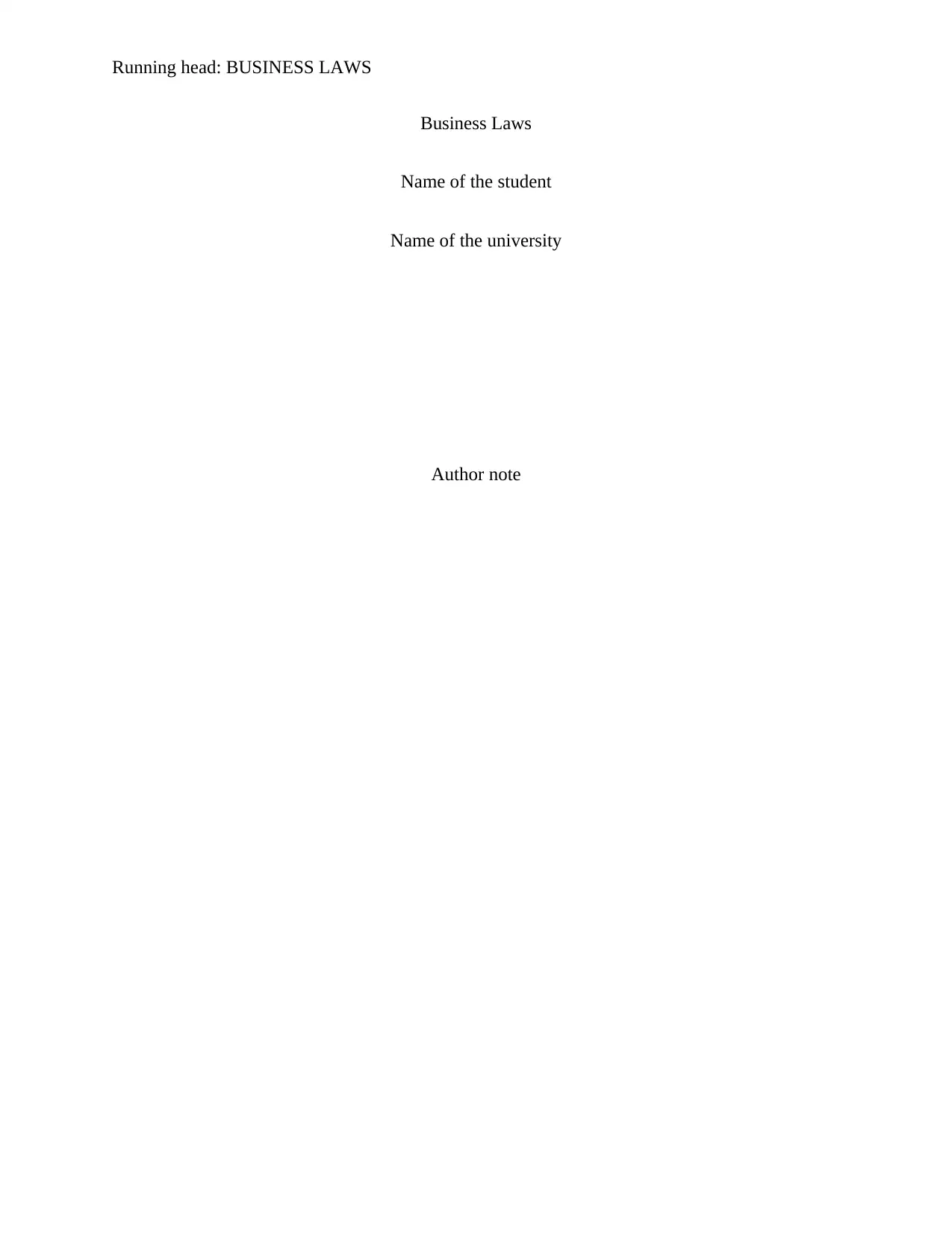
Running head: BUSINESS LAWS
Business Laws
Name of the student
Name of the university
Author note
Business Laws
Name of the student
Name of the university
Author note
Paraphrase This Document
Need a fresh take? Get an instant paraphrase of this document with our AI Paraphraser
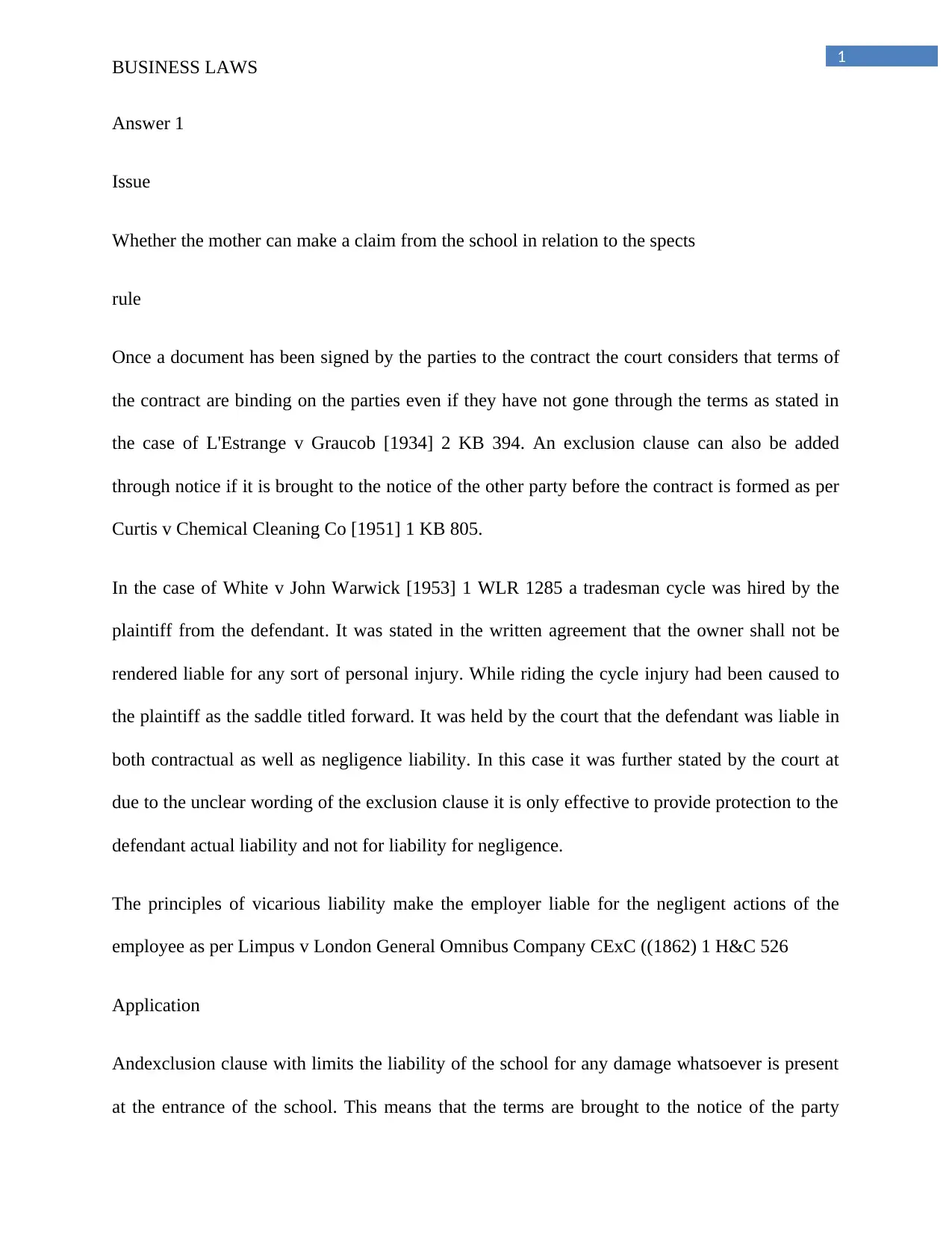
1
BUSINESS LAWS
Answer 1
Issue
Whether the mother can make a claim from the school in relation to the spects
rule
Once a document has been signed by the parties to the contract the court considers that terms of
the contract are binding on the parties even if they have not gone through the terms as stated in
the case of L'Estrange v Graucob [1934] 2 KB 394. An exclusion clause can also be added
through notice if it is brought to the notice of the other party before the contract is formed as per
Curtis v Chemical Cleaning Co [1951] 1 KB 805.
In the case of White v John Warwick [1953] 1 WLR 1285 a tradesman cycle was hired by the
plaintiff from the defendant. It was stated in the written agreement that the owner shall not be
rendered liable for any sort of personal injury. While riding the cycle injury had been caused to
the plaintiff as the saddle titled forward. It was held by the court that the defendant was liable in
both contractual as well as negligence liability. In this case it was further stated by the court at
due to the unclear wording of the exclusion clause it is only effective to provide protection to the
defendant actual liability and not for liability for negligence.
The principles of vicarious liability make the employer liable for the negligent actions of the
employee as per Limpus v London General Omnibus Company CExC ((1862) 1 H&C 526
Application
Andexclusion clause with limits the liability of the school for any damage whatsoever is present
at the entrance of the school. This means that the terms are brought to the notice of the party
BUSINESS LAWS
Answer 1
Issue
Whether the mother can make a claim from the school in relation to the spects
rule
Once a document has been signed by the parties to the contract the court considers that terms of
the contract are binding on the parties even if they have not gone through the terms as stated in
the case of L'Estrange v Graucob [1934] 2 KB 394. An exclusion clause can also be added
through notice if it is brought to the notice of the other party before the contract is formed as per
Curtis v Chemical Cleaning Co [1951] 1 KB 805.
In the case of White v John Warwick [1953] 1 WLR 1285 a tradesman cycle was hired by the
plaintiff from the defendant. It was stated in the written agreement that the owner shall not be
rendered liable for any sort of personal injury. While riding the cycle injury had been caused to
the plaintiff as the saddle titled forward. It was held by the court that the defendant was liable in
both contractual as well as negligence liability. In this case it was further stated by the court at
due to the unclear wording of the exclusion clause it is only effective to provide protection to the
defendant actual liability and not for liability for negligence.
The principles of vicarious liability make the employer liable for the negligent actions of the
employee as per Limpus v London General Omnibus Company CExC ((1862) 1 H&C 526
Application
Andexclusion clause with limits the liability of the school for any damage whatsoever is present
at the entrance of the school. This means that the terms are brought to the notice of the party
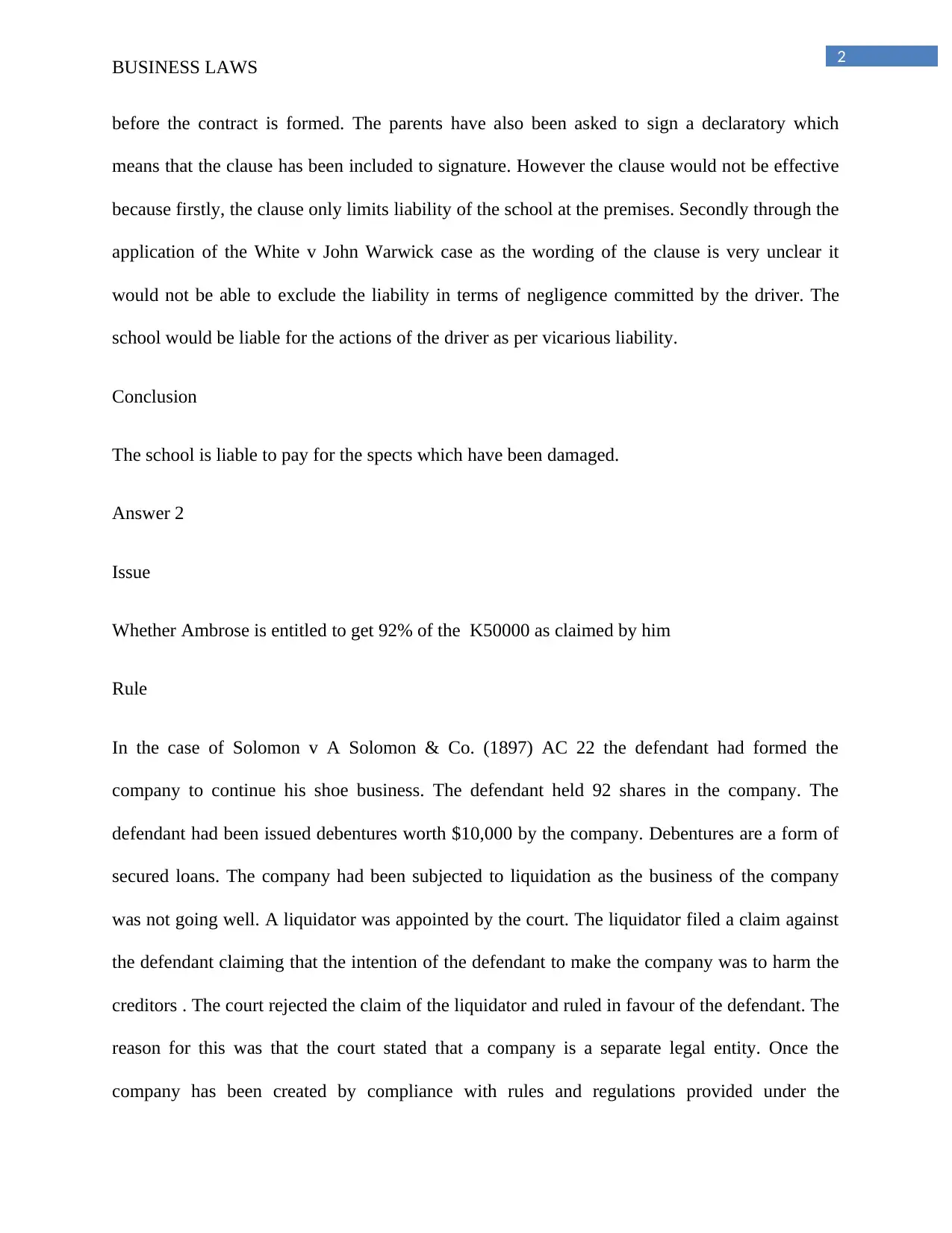
2
BUSINESS LAWS
before the contract is formed. The parents have also been asked to sign a declaratory which
means that the clause has been included to signature. However the clause would not be effective
because firstly, the clause only limits liability of the school at the premises. Secondly through the
application of the White v John Warwick case as the wording of the clause is very unclear it
would not be able to exclude the liability in terms of negligence committed by the driver. The
school would be liable for the actions of the driver as per vicarious liability.
Conclusion
The school is liable to pay for the spects which have been damaged.
Answer 2
Issue
Whether Ambrose is entitled to get 92% of the K50000 as claimed by him
Rule
In the case of Solomon v A Solomon & Co. (1897) AC 22 the defendant had formed the
company to continue his shoe business. The defendant held 92 shares in the company. The
defendant had been issued debentures worth $10,000 by the company. Debentures are a form of
secured loans. The company had been subjected to liquidation as the business of the company
was not going well. A liquidator was appointed by the court. The liquidator filed a claim against
the defendant claiming that the intention of the defendant to make the company was to harm the
creditors . The court rejected the claim of the liquidator and ruled in favour of the defendant. The
reason for this was that the court stated that a company is a separate legal entity. Once the
company has been created by compliance with rules and regulations provided under the
BUSINESS LAWS
before the contract is formed. The parents have also been asked to sign a declaratory which
means that the clause has been included to signature. However the clause would not be effective
because firstly, the clause only limits liability of the school at the premises. Secondly through the
application of the White v John Warwick case as the wording of the clause is very unclear it
would not be able to exclude the liability in terms of negligence committed by the driver. The
school would be liable for the actions of the driver as per vicarious liability.
Conclusion
The school is liable to pay for the spects which have been damaged.
Answer 2
Issue
Whether Ambrose is entitled to get 92% of the K50000 as claimed by him
Rule
In the case of Solomon v A Solomon & Co. (1897) AC 22 the defendant had formed the
company to continue his shoe business. The defendant held 92 shares in the company. The
defendant had been issued debentures worth $10,000 by the company. Debentures are a form of
secured loans. The company had been subjected to liquidation as the business of the company
was not going well. A liquidator was appointed by the court. The liquidator filed a claim against
the defendant claiming that the intention of the defendant to make the company was to harm the
creditors . The court rejected the claim of the liquidator and ruled in favour of the defendant. The
reason for this was that the court stated that a company is a separate legal entity. Once the
company has been created by compliance with rules and regulations provided under the
⊘ This is a preview!⊘
Do you want full access?
Subscribe today to unlock all pages.

Trusted by 1+ million students worldwide
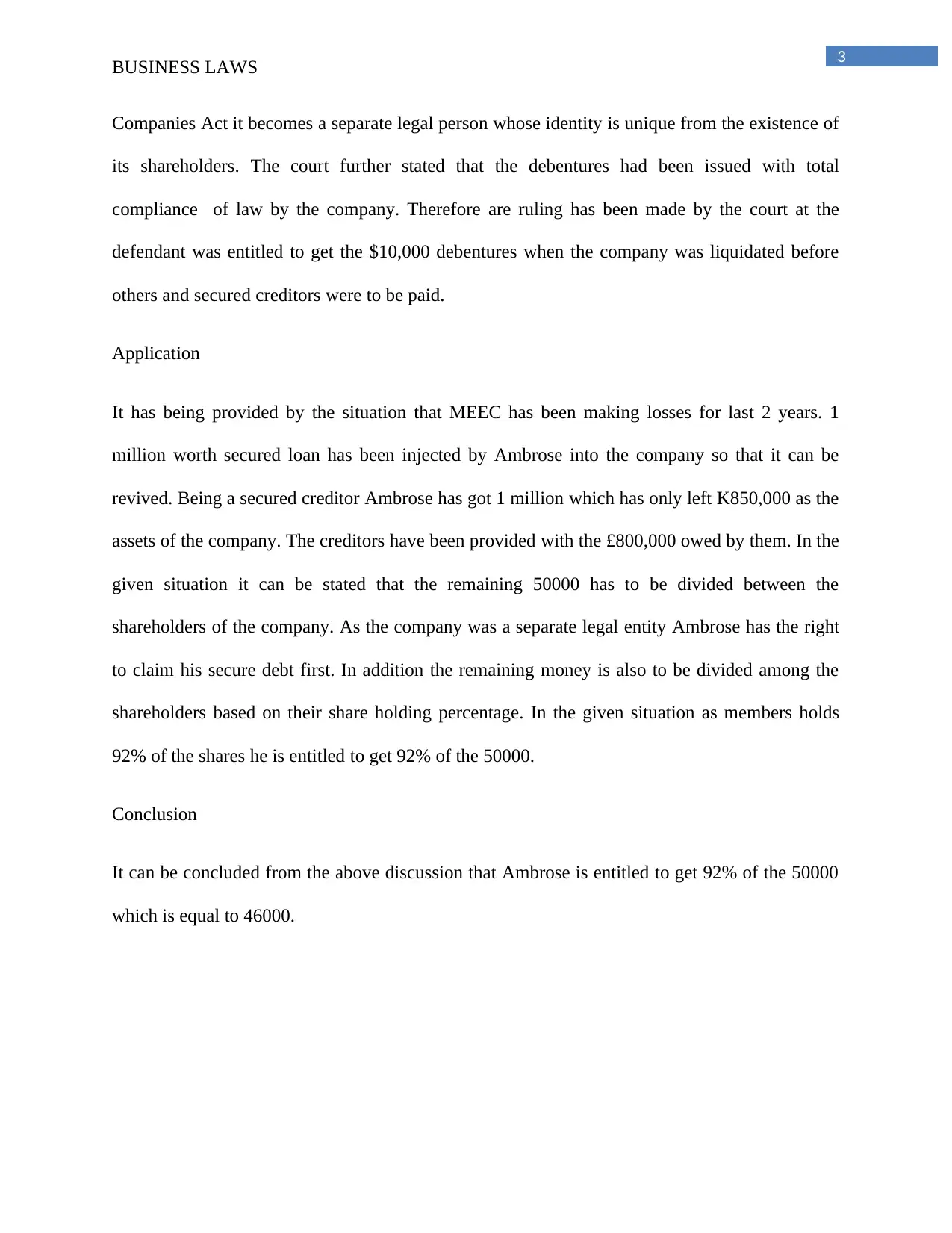
3
BUSINESS LAWS
Companies Act it becomes a separate legal person whose identity is unique from the existence of
its shareholders. The court further stated that the debentures had been issued with total
compliance of law by the company. Therefore are ruling has been made by the court at the
defendant was entitled to get the $10,000 debentures when the company was liquidated before
others and secured creditors were to be paid.
Application
It has being provided by the situation that MEEC has been making losses for last 2 years. 1
million worth secured loan has been injected by Ambrose into the company so that it can be
revived. Being a secured creditor Ambrose has got 1 million which has only left K850,000 as the
assets of the company. The creditors have been provided with the £800,000 owed by them. In the
given situation it can be stated that the remaining 50000 has to be divided between the
shareholders of the company. As the company was a separate legal entity Ambrose has the right
to claim his secure debt first. In addition the remaining money is also to be divided among the
shareholders based on their share holding percentage. In the given situation as members holds
92% of the shares he is entitled to get 92% of the 50000.
Conclusion
It can be concluded from the above discussion that Ambrose is entitled to get 92% of the 50000
which is equal to 46000.
BUSINESS LAWS
Companies Act it becomes a separate legal person whose identity is unique from the existence of
its shareholders. The court further stated that the debentures had been issued with total
compliance of law by the company. Therefore are ruling has been made by the court at the
defendant was entitled to get the $10,000 debentures when the company was liquidated before
others and secured creditors were to be paid.
Application
It has being provided by the situation that MEEC has been making losses for last 2 years. 1
million worth secured loan has been injected by Ambrose into the company so that it can be
revived. Being a secured creditor Ambrose has got 1 million which has only left K850,000 as the
assets of the company. The creditors have been provided with the £800,000 owed by them. In the
given situation it can be stated that the remaining 50000 has to be divided between the
shareholders of the company. As the company was a separate legal entity Ambrose has the right
to claim his secure debt first. In addition the remaining money is also to be divided among the
shareholders based on their share holding percentage. In the given situation as members holds
92% of the shares he is entitled to get 92% of the 50000.
Conclusion
It can be concluded from the above discussion that Ambrose is entitled to get 92% of the 50000
which is equal to 46000.
Paraphrase This Document
Need a fresh take? Get an instant paraphrase of this document with our AI Paraphraser
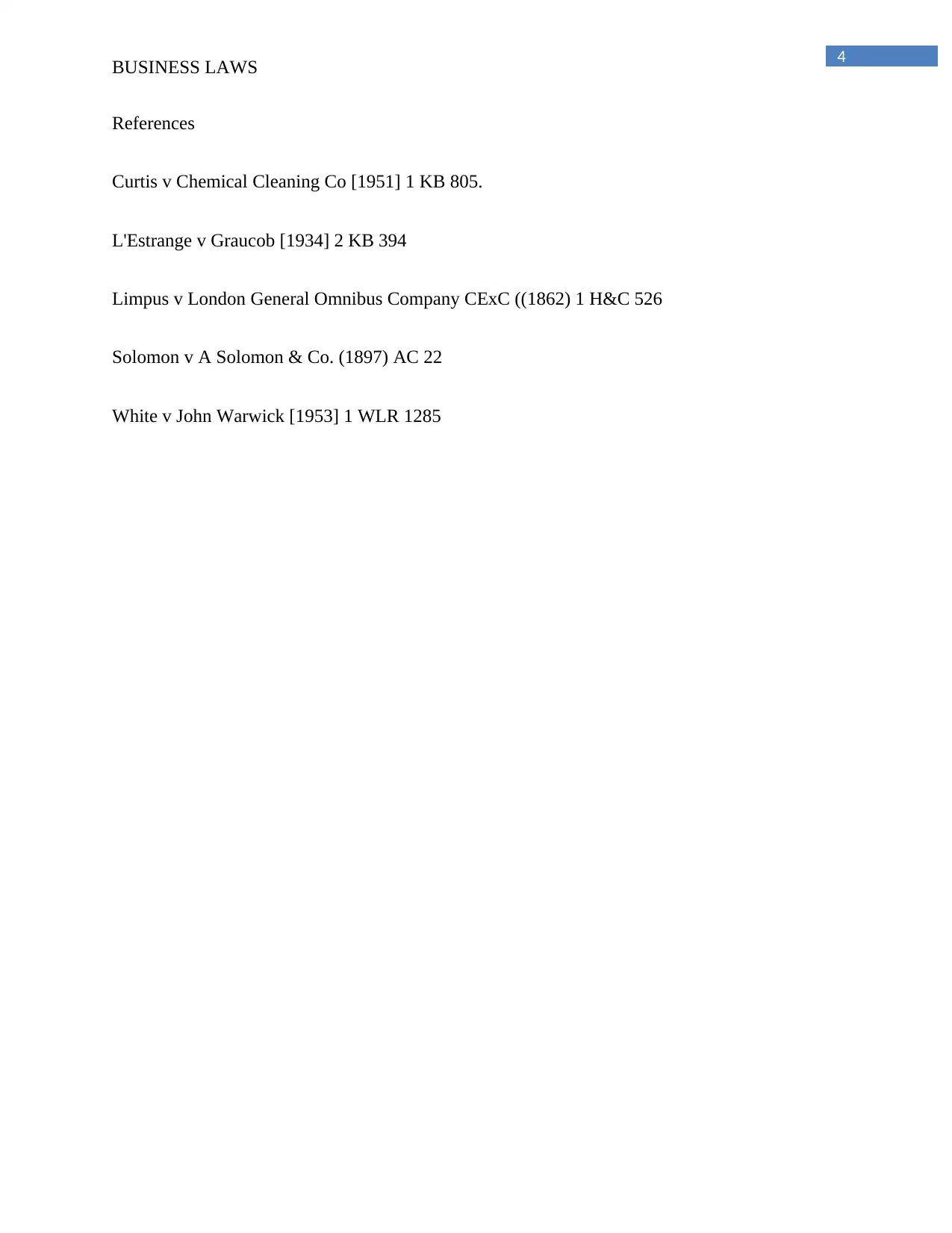
4
BUSINESS LAWS
References
Curtis v Chemical Cleaning Co [1951] 1 KB 805.
L'Estrange v Graucob [1934] 2 KB 394
Limpus v London General Omnibus Company CExC ((1862) 1 H&C 526
Solomon v A Solomon & Co. (1897) AC 22
White v John Warwick [1953] 1 WLR 1285
BUSINESS LAWS
References
Curtis v Chemical Cleaning Co [1951] 1 KB 805.
L'Estrange v Graucob [1934] 2 KB 394
Limpus v London General Omnibus Company CExC ((1862) 1 H&C 526
Solomon v A Solomon & Co. (1897) AC 22
White v John Warwick [1953] 1 WLR 1285
1 out of 5
Related Documents
Your All-in-One AI-Powered Toolkit for Academic Success.
+13062052269
info@desklib.com
Available 24*7 on WhatsApp / Email
![[object Object]](/_next/static/media/star-bottom.7253800d.svg)
Unlock your academic potential
Copyright © 2020–2025 A2Z Services. All Rights Reserved. Developed and managed by ZUCOL.



